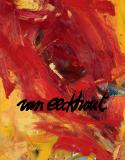
Willy VAN EECKHOUT
ga jij maar schilderen …

On December 6th of 2018, 33 maps with ARCHIVE MATERIALS starting from 1960, that encapsulate the archive of Willy Van Eeckhout, were donated to the MuHKA in Antwerp. This is a museum, but also an ARCHIVE OF FLEMISH MODERN AND CONTEMPORARY ART.
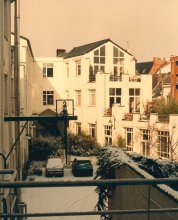
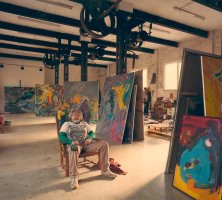
Flemish painter, born in Mechelen (Malines, Belgium), 1943.
Education: Royal Academy of Fine Arts of Mechelen - National Higher Institute of Antwerp - State Normal School for Art in Hasselt - State Higher Institute for Arts of Brussels.
The artist lives and works in De Gieterij, a renovated foundry close to the Malines central railway station. The studio of 200m2 enables the creation of big works.
The paintings of Van Eeckhout are expressive, mysterious, nearly undefinable, suggestive and always done with a swinging technique.
He deserts figuration in 1965 and adopts abstraction. Influential for this new artistic direction are Walter Vilain and Kandinsky’s book Das Geistige in der Kunst. This change happens in the full Op- and Pop Art period. He chooses this mode of expression because he thinks that it is the freest, most universal, most spiritual and most in-depth way of artistic creation. A pictural « fever » wells up at regular intervals – the intimate necessity – and needs to be satiated in joyful painting with a great love for the holy oilpaint. Colour and form get a proper identity and create as by magic a mysterious ambience which one needs to undergo profoundly and attentively, as when one listens to music of quality. The making of art is an evasion from the daily worries and has a therapeutic effect. Being a fervent jazzfan, Van Eeckout created numerous JAZZPAINTINGS in the seventies. Many homages to jazz musicians are still traceable in his recent paintings.
In the nineties Van Eeckhout painted also often on big canvases, with large gestures and big paintbrushes in a wide range of intense colours with dark yellow at their core, a joyous salutation with Heimlich Gelb. And then the painter JAS gave him a very large number of small butter tubs containing self-made and already self-mixed oilpaints, resulting in a superposition of layers of different colours, which can be selectively spread with a palette knife on the canvas – la patte de l’artiste – resulting in a thrilling picturality that invades the work with a powerful and virile identity. The overall aspect is somewhat greyish and purple, but it becomes an exploration of its limits, which offers wonderful and unexpected possibilities that would never have been discovered with Van Eeckhout’s own paints. The works seem to be abstract, at first sight, but are in fact and in a somewhat concealed way, « figurative ». They are not the images of reality but its spiritual echo, i.e. SUGGESTIVE : each touch of the palette knife suggests and forms a more or less recognizable styling, a pattern, that enables the viewer to be creative thanks to his own interpretation. Although this « figuration » is not sought-after, it strongly surprises the viewer and arises from the depths of his own subconscience.
The roots of Van Eeckhout’s paintings are to be found in the works of Willem de Kooning, Bram van Velde, Asgern Jorn, Englebert Van Anderlecht, Kurt Schwitters, Paul Joostens and last but not least Jules Schmalzigaug.
Van Eeckhout has been instrumental in maintaining the strength of the art of painting. And still is.
The origin of his PALIMPSESTS is to be found in his COLLAGES of 1965-1966. To arrange, to relocate, to rip, to cut, to stick is more playful than to paint, but these actions are in fact to paint with paper and it is the love for this material that is decisive here. The contours can take all possible shapes. Once pasted, some parts are painted over in transparence, with acrylic or gouache. There is also a graphic angle thanks to drawings with pen, paintbrush or crayons. Van Eeckhout uses old, somewhat worn-out documents which are mainly autobiographical. They are musical scores, writings, stamps, cigar bands, wine and beer labels, old judicial texts. He is indeed a « conservator » of his past. On the initiative of Piet De Groof (Walter Korun), some palimpsests were created in collaboration with authors : Willem M. Roggeman, Frans Boenders, Rob Goswin and Guy van Hoof. Also with Emile Verhaeren and the visual artists Edith Van Driessche and Vincent Van Gogh, with the integration of fragments of their poetry in their own handwriting or with copies hereof. The intimacy and the authentic character of the handwriting is very important in Van Eeckhout’s eyes, and it is at the same time a form of drawing.
PALIMPSEST: samenwerking met Frans Boenders.
DE BOTERVLOOTJES
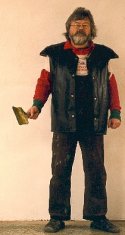
Mark Ruyters - (H)ART 08/03/2007 (free translation of a Dutch text by Marc Ruyters )
During the last 40 years Willy Van Eeckhout has eagerly defended abstract and gesture-related painting. In his previous works, he has exerted himself physically, but always with the necessary know-how, having kept in mind the lessons of the Flemish expressionists and of the American abstract expressionists.
He says that his latest creations are now definitely more appeased, as he uses the painting-knife instead of the brush. However, he continues to prefer an exuberant mixture of oils, colours, tonalities and pastes, affixed in broad lines.
On the other hand he also creates what he calls his “palimpsests”, which are works on paper on which scriptures, colours, poems, pieces of paper, gouaches and water-colours are superimposed, in various layers.
His recent canvasses have another characteristic : Willy Van Eeckhout uses paint which he received from JAS, a fellow-painter. This artist made and mixed himself his own colours and oils, and stored them in small plastic boxes. At first sight one might think that they are of a dominant grey-violet colour, but a judicious manipulation with the painting-knife results into astonishing tonalities. Actually, the present works are somewhat greyer than the previous ones. Van Eeckhout calls his new manner ‘homage to JAS”. The new era will last for quite a long time, until the last of the many plastic boxes will have been emptied.
Willem M. Roggeman - 1989
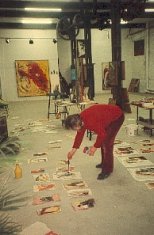 For a number of years, Willy Van Eeckhout has been producing two different sorts of work that complement each other in an unusual way. On the one hand there ware the oil or acrylic paintings on canvas, for which the description "Lyrical Abstraction" may be used, and whose most striking features are the importance of large, broad gestures and the use of pure, unmixed colours ...
For a number of years, Willy Van Eeckhout has been producing two different sorts of work that complement each other in an unusual way. On the one hand there ware the oil or acrylic paintings on canvas, for which the description "Lyrical Abstraction" may be used, and whose most striking features are the importance of large, broad gestures and the use of pure, unmixed colours ...
... On the other hand there are the so-called palimpsests, works in acrylics or mixed media on both types that are autobiographical in character, though this is not equally clearly present in every work.
The paintings on canvas appear entirely abstract, and are so intented by the artist, but on closer examination one can yet discern figurative elements in them. These elements have eluded the control of reason and have crept unconsiously into the painting. The artist is only able to ascertain their presence when the painting is complete. The figurative elements that emerge from the play of lines and the areas of bright colour are not an explicit presence, but, rather, allude to plants, an arm, a leg, a torso or eyes. It is an organic world that is subtly evoked rathter tha directly expressed. They are fragments from a larger whole that is itself not expressed, which remains concealed or is reproduced under heavy disguise, hidden behind expansive gestures in paint richly and enthusiastically applied.
Each composition is born of chaos ...
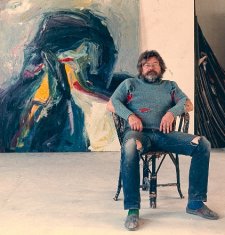
Wim Toebosch - 1996
Willy Van Eeckhout is an impassionate, eruptive painter. Human beings and plants or impulses are reduced to large and audac brush-strokes which, such as currents in a wild river, flow agains each other and create a structure that concentrates an intense pow small space. It is in fact an abstract expressionism which does not reject but dissolves figuration in a powerful play of colours.
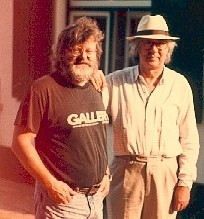
An evolution from the figurative drawings and paintings to the abstract oil-paintings and collages took place, largely under Walter Vilain's influence.
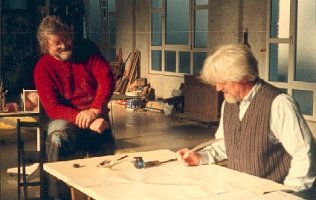
In collaboration with authors like Willem M. Roggeman, Rob Goswin, Guy van Hoof and Frans Boenders, Van Eeckhout also produces contemporary palimsests, in which the legible and the illegible embrace each other: a tender masculine embrace of script and image. The critic Rob Goswin has described these paper works of art as 'plastic gems with vital coulour tones and corresponding gestural, almost calligraphic, signs' . |
|
1) Collaboration with met Rob Goswin |